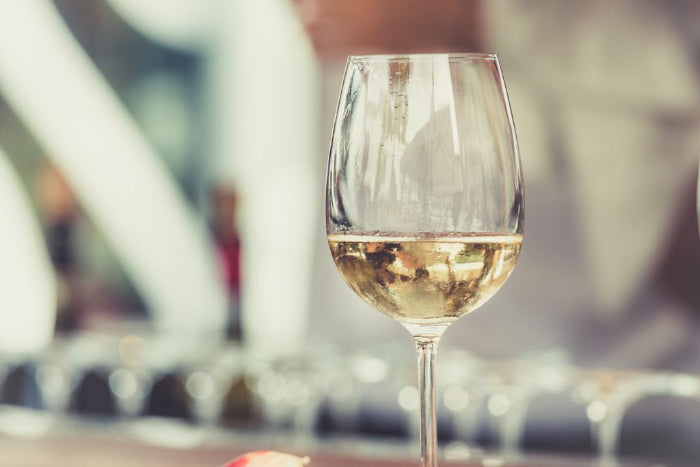Muscadet Wine
Not to be confused with Moscato, Muscat or Moscatel, all white Mediterranean grapes used to make sweet wine; Muscadet is not a grape but a place, a type of wine and a lifestyle.
What is Muscadet? When we talk about Muscadet, we discuss an appellation of origin or AOP in the Loire Valley, France. In fact, this is the westernmost appellation in the prestigious region, and it overlooks the Atlantic Ocean.
Here the cold, rainy climate prevents grape growers from cultivating most wine grapes; only a few varietals survive the harsh Atlantic conditions. In Muscadet, that grape is Melon de Bourgogne.
What is Muscadet? & How it can be confused with Muscat
Muscadet is produced mainly in the
Loire region and is a dry white wine. The difference is,
Muscat Sec and other Muscat Varieties are from other regions across France and are sweet dessert wines.
Muscadet is a table wine typically made from the
Melon de Bourgogne grape, which is recommended to be served chilled with food pairings, such as poultry.
What is Muscadet Sur Lie?
'Sur Lie' refers to the ageing of the wine, translating to 'ageing on the Lees'. This process is the ageing of wine on dead yeast particles, left over from the fermentation process, adding extra complexity and flavours to the wines. They must be left to age for 6 months in order to qualify for 'Sur Lie'
As the yeast particles break down in the Sur Lie process, amino acids and small amounts of sugars (polysaccharides) are released into the wine, adding to the wine's complexity. Ageing on the Lees can take anything from 3 months to several years, depending upon the wine.
The Bâtonnage Sur Lie technique refers to the stirring of the settled lees during this process, which increases the surface area of which the yeast particles come into contact with the wine. Additionally, stirring the particles during the ageing process, the risk of hydrogen sulfide being produced is minimised.
Yeast turns the sugar in grape juice into alcohol, turning it into wine. The yeast eventually dies, and it’s regularly separated from the wine by decanting it into a second vessel or by filtration. Still, the spent yeast can change the wine’s flavour, aromatic profile and mouthfeel.
Allowing fermented wine to rest or age over lees or on its lees is to leave it with the dead yeast cells for weeks, months or years. This is typical for Muscadet wines, but it’s also common in Burgundy for Chardonnay and Champagne for the world’s most exclusive sparkling wines. Not all Muscadet experiences extended lees ageing, but the one that does is one of the most extraordinary wines in France.
What Does Muscadet Taste Like?
Melon de Bourgogne is indeed a Burgundian grape, now almost exclusively found in Muscadet, around the town of Nantes. The grape is prized in the region for its ability to withstand the cold and moist climate prevalent in the coastal area.
Melon de Bourgogne is not particularly flavourful but crisp and lean, and it retains high acidity levels. The wines made with it are light-bodied and tart, citrusy and mineral. This led producers to go the extra mile and use unique techniques to give complexity to Muscadet. In other words, Sur Lie ageing.
What is the difference between Gros Lees and Fine Lees?
Gross Lees refers to the sediment that falls to the bottom of the wine vessel (think of the sediment in unfiltered wine). However, these wines are normally filtered before or after the fermentation process.
Fine Lees are the smaller particles left in the wine, which settle a lot slower. These may also be removed from the wine after fermentation, however, it is a lot more common for winemakers to not filter these, as the particles add flavour and complexity, and 'body' to the wine as it ages.

What is Muscadet Sevre Et Maine?
Muscadet Sevre Et Maine is the largest sub-appellation which produces this wine using the Sur Lie process in their winemaking- one of few appellations that are certified for Sur Lie wines! The land in Muscat-Sevre Et Maine is ideal for production of the muscadet because of the combination of volcanic, metamorphic and alluvial soils, leading to high levels of magnesium, calcium and potassium.
The Appellations in Muscadet
Four appellations protect and guarantee the quality of this exciting wine style, Muscadet, the umbrella AOP for the entire region, and three smaller sub-regions, where the wine is consistently higher quality: Cotes de Grandlieu, Coteaux de la Loire, and the famous Muscadet Sevre-et-Maine.
All three appellations champion Melon de Bourgogne, the leading grape in the region since the great winter frost of 1709 that eliminated all competition. And although the noble varietal produces stimulating wines with great versatility on the table, the winemaking methods emblematic in the area are a significant part of Muscadet’s success.
Food Pairing with Muscadet Wine
Melon is the perfect variety to produce invigorating white wines that go great with the region’s seafood. Still, the lees ageing makes it more versatile, bold enough to tackle pairings with oily fish, white meat and creamy sauces.
Muscadet is the ultimate seafood wine, but it is also delicious on its own as an apéritif. The most exemplary wine and food pairing for Muscadet involves the region’s oysters, mussels and clams. Coquilles, anyone? There’s more: Muscadet is well priced for its quality, making it a connoisseur’s secret — one we’re now sharing with you. Add Muscadet to your wine rotation and enjoy one of the most refreshing wines on earth.
Our Favourite Muscadet...









